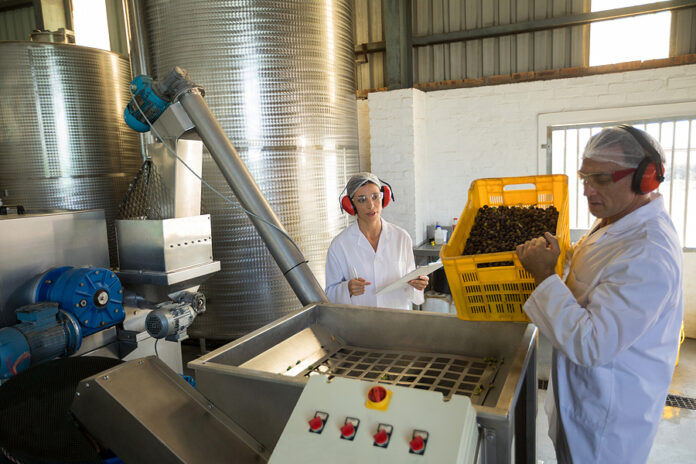
By Katie Koebel, Audiologist and Senior Manager of Audiology at HearingLife
Key Takeaways:
-
The food manufacturing industry exposes workers to high noise levels from machinery, leading to a significant risk of hearing loss. It’s crucial to recognize this risk and take proactive measures to protect employees’ hearing.
-
Implementing comprehensive hearing conservation programs that include noise monitoring, reduction strategies, hearing protection equipment, and regular hearing tests is essential for mitigating the risk of hearing loss and complying with regulations.
-
Prioritizing hearing health not only safeguards employees’ well-being but also leads to increased productivity, improved morale, a strong safety culture, and long-term cost savings for the company.
Noise-induced hearing loss is a significant concern in the food manufacturing industry, where employees are frequently exposed to high decibel levels from various machinery and equipment. Understanding and mitigating these risks is crucial for protecting workers’ hearing health and ensuring a safe and productive work environment.
Numerous sources of hazardous noise in food manufacturing must be contended with, in addition to legal and regulatory requirements for managing noise exposure. As a result, implementing comprehensive hearing conservation programs is an effective strategy to prioritize hearing health. Through this, companies can enhance employee well-being, boost productivity, and achieve long-term cost savings, ultimately fostering a safer and more sustainable industry.
Understanding the risks
Any noise above 85 dB (decibels, the unit used to measure sound) can cause hearing loss over a certain period of time, with noises above 120 dB able to cause immediate and profound hearing loss. In the food manufacturing industry, there are plenty of loud noises that can exceed this threshold throughout the course of a shift, including:
- Compressed air: 120 to 130 dB
- Power saws: up to 100 dB
- Packaging machinery: 85 to 90 dB
- Hammer mills: 95 to 100 dB
- Pressure washer: 70 to 100 dB
Within the manufacturing industry, about 18% of workers report having hearing difficulties, 11% have tinnitus, and 28% report that they don’t use hearing protection.
Legal and regulatory requirements
When noise levels reach above 80 dB over an eight-hour period, the Canadian Centre for Occupational Health and Safety (CCOHS) recommends implementing a hearing conservation program. According to Ontario’s Noise Regulation, which applies to all workplaces covered by the Occupational Health and Safety Act, the highest acceptable exposure limit is 85 dB, averaged over an eight-hour period. The Occupational Safety and Health Administration (OSHA) has a similar standard, requiring employers to implement a hearing conservation program at average noise exposure levels at or above 85 decibels over an eight-hour period.
Implementing effective hearing conservation programs
If your workplace exceeds the limits outlined above, it’s paramount to implement a hearing conservation program. This would include a training and awareness course for employees and management, appropriate hearing protection equipment, and regular audiometric testing for employees.
Noise monitoring
To understand the noise level during an average workday, you can conduct noise monitoring and assess it. This can be done using a sound meter — either one placed near vital pieces of equipment to gauge their noise level throughout the day or one placed on an employee’s person to gauge how much noise they’re exposed to. Once you know the noise level, you can understand how much noise reduction is required to keep employees’ hearing safe.
Noise reduction
Noise can be reduced either at the source, by setting up a barrier between the noisy equipment and the operator, or at the ear. To reduce it at the ear, employees can wear earplugs or earmuffs that can reduce noise levels by 20 to 35 dB, depending on the type of ear protection. There can also be a job rotation implemented to put employees on quieter jobs for part of their shifts, so as not to exceed the 85 dB average requirement, or quiet periods implemented throughout the day where noise cannot exceed a certain level.
Hearing tests
Employee and management training is also vital so that everyone understands the risks and what they can do to mitigate them. Providing them with regular hearing tests will ensure that everyone is aware of the current state of their hearing health and will catch signs of hearing loss early so that it can be addressed.
The role of employees
A large portion of manufacturing workers don’t wear hearing protection, even though the sounds in the manufacturing industry can exceed the 85 dB daily average. Emphasizing the importance of hearing protection for the improvement of long-term health outcomes and ensuring that employees understand the importance of the hearing conservation program can help to increase compliance, which will reduce the prevalence of hearing loss in manufacturing.
Employees should also report and address potential noise hazards, such as equipment that has become louder than usual or new equipment that is louder than accounted for.
Benefits of prioritizing hearing health
Prioritizing hearing health benefits all levels of the food manufacturing industry. Reducing the prevalence and instances of hearing loss will improve employee well-being and quality of life. This effect will also help to increase their productivity and reduce absenteeism due to hearing difficulties, pain, or emergency appointments.
Improved hearing health and a concern for employee welfare improve morale and create a workplace safety culture where employees and managers are concerned with everyone’s safety in all areas — extending beyond hearing health.
Hearing conservation programs also increase long-term cost savings for the company. They may reduce the amount they need to pay for employees’ disability or medical costs, as fewer employees will end up needing hearing aids.
The importance of hearing health in food manufacturing
Prioritizing hearing health in the food manufacturing industry is not just a regulatory requirement but a critical aspect of ensuring the overall well-being of employees. By understanding the risks associated with noise exposure, implementing effective hearing conservation programs, and fostering a culture of safety, companies can significantly reduce the incidence of hearing loss and improve the quality of life for their workers.
Encouraging the use of hearing protection, conducting regular training, and maintaining open communication about potential hazards are essential steps in this process. The benefits of such initiatives extend beyond compliance, leading to enhanced employee morale, increased productivity, and long-term cost savings. Ultimately, safeguarding hearing health is an investment in both the safety and success of the workforce and the industry as a whole.
 Katie Koebel is an Audiologist and Senior Manager of Audiology at HearingLife, Canada’s largest group of hearing centers. Katie is an Audiologist registered with CASLPO and has been providing her clients with the best possible hearing care with HearingLife for over 17 years.
Katie Koebel is an Audiologist and Senior Manager of Audiology at HearingLife, Canada’s largest group of hearing centers. Katie is an Audiologist registered with CASLPO and has been providing her clients with the best possible hearing care with HearingLife for over 17 years.








